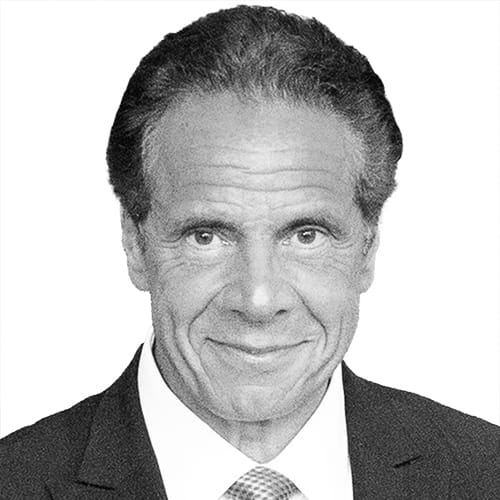We have just experienced a political rollercoaster of personal dramas. Donald Trump’s indictments. The assassination attempt on him. Joe Biden’s condition.
Hopefully, we have stepped off the ride: Trump is the Republican, and Kamala Harris the likely Democratic, candidate.
Great!
I worked with Vice President Harris as an attorney general and she was a national star. I know what it's like to be AG and to be effective, you have to know the facts, forcefully prosecute your argument and see your case through to fruition. These are abilities Kamala Harris possesses and will aid her in this moment.
She also served as a United States senator and, of course, is the Vice President. She is uniquely qualified to run and win, and brings with her a “passing the torch to a new generation” energy with her.
The next challenge is for the Democratic Party to focus on the needs of the country.

Harris was at an Oval Office meeting with Pres. Biden, then Gov. Cuomo and governors Asa Hutchinson (R-AR), Michelle Lujan Grisham (D-NM) and Larry Hogan (R-MD), on the American Rescue Plan in February 2021.
Pete Marovich/Poll/Getty ImagesWhile we have lost focus in the maelstrom of personal and party sideshows, the central issue of the day remains: What are we going to do about the chaos engulfing our nation?
Let’s revisit the essential theoretical premise: Campaigns are about identifying and prioritizing current problems and proposing solutions to resolve those issues. The candidate with the most persuasive agenda wins the election. That is still the rational theory.
For example, of course everyone wants a cease-fire in the Middle East: People favor peace over war, but how do you accomplish it, get back the hostages and end the terror of Hamas?
The Democratic Party must answer the border question and what do we do with the hundreds of thousands of migrants already in the country. Trump says deport them. He will have ICE enter every urban area deporting new migrants and also the undocumented. He tried it before. What is the Democrats answer?
Consumer purchasing power is reduced, and families are struggling. What would really make a difference?
All but ignored, but critical is the looming crisis of urban America. Our cities are in deep decline and “as go our cities, so goes our nation.”
New York City, San Francisco, Los Angeles, Chicago, Portland and scores of medium-sized cities offer undeniably vivid displays of decline.

The evidence of urban decay is widespread, including in the Harbor City section of Los Angeles.
Bing Guan/ReutersCrime, homelessness, the mentally ill, and a second-rate urban education system are major problems. Politicians in recent months have wrapped themselves in studies that suggest conditions are getting better, but people trust their own instincts over government data. Americans)" href="https://urldefense.com/v3/__https://www.oregonlive.com/politics/2024/05/these-3-pressing-problems-remain-a-top-concern-for-portland-area-voters-poll-finds.html__;!!LsXw!SkZPp9MN3NdFvRlxP1kfd9RecjbieDUjMU73pTebOB9AP7Imm5FjWXq_pEJvEesYrbANU_nEeBq3-S7gkeMGPYU01XfPqg$">Americans across)" href="https://urldefense.com/v3/__https://www.washingtonpost.com/dc-md-va/2024/05/16/dc-poll-fear-crime-rising/__;!!LsXw!SkZPp9MN3NdFvRlxP1kfd9RecjbieDUjMU73pTebOB9AP7Imm5FjWXq_pEJvEesYrbANU_nEeBq3-S7gkeMGPYVooLyv_g$">across the country)" href="https://urldefense.com/v3/__https://www.baltimoresun.com/2024/04/17/poll-issues-key-bridge-harborplace-crime/__;!!LsXw!SkZPp9MN3NdFvRlxP1kfd9RecjbieDUjMU73pTebOB9AP7Imm5FjWXq_pEJvEesYrbANU_nEeBq3-S7gkeMGPYVO_K1eZg$">country aren’t buying)" href="https://urldefense.com/v3/__https://www.wsmv.com/2024/04/04/crime-ranks-top-issue-nashville-residents-want-addressed-new-poll/__;!!LsXw!SkZPp9MN3NdFvRlxP1kfd9RecjbieDUjMU73pTebOB9AP7Imm5FjWXq_pEJvEesYrbANU_nEeBq3-S7gkeMGPYXARWTUhg$">buying it and the polls)" href="https://urldefense.com/v3/__https://news.gallup.com/poll/544442/americans-crime-problem-serious.aspx__;!!LsXw!SkZPp9MN3NdFvRlxP1kfd9RecjbieDUjMU73pTebOB9AP7Imm5FjWXq_pEJvEesYrbANU_nEeBq3-S7gkeMGPYWgAy_GZA$">polls show it. In New York)" href="https://urldefense.com/v3/__https://scri.siena.edu/wp-content/uploads/2024/06/SNY0624-Crosstabs.pdf__;!!LsXw!SkZPp9MN3NdFvRlxP1kfd9RecjbieDUjMU73pTebOB9AP7Imm5FjWXq_pEJvEesYrbANU_nEeBq3-S7gkeMGPYXuN1PGRQ$"> New York, 49 percent say crime’s gotten worse in the last year, 17 percent said it’s gotten better and the rest said it’s stayed the same. If that’s New York, where do you think the rest of the country is?
Compounding the situation is the post-Covid economic and social reality and technological advancements that provides people more mobility to leave the hardships posed by urban life, taking with them vital tax dollars and major contributors to the local economy. Local and state governments have failed to address the issues in part due to lack of resources and in part because they are politically paralyzed by extremist ideologues.
Right-leaning communities have elected leaders in the MAGA mold, while many blue communities have elected extreme-left politicians. If an issue presents itself that’s outside one of those respective ideological frames, good luck finding a solution because the moderates are intimidated into silence and the far left and far right are emboldened.
The federal government has hurt urban areas more than it has helped by failing to repeal the damaging tax policies of the first Trump administration that capped the deductibility of state and local taxes—effectively doubling taxes in many of these struggling urban areas.

Harris will face a relentless stream of lies from Trump but she must answer with a properly argued set of facts which set out a real program for when she is in office, writes Cuomo.
Tom Brenner/ReutersIn addition, the mishandling of the federal migrant crisis aggravated the urban decline. The federal government has historically been responsible for providing the bulk of the funding for affordable housing, but the need far outweighs the demand and available resources. What do we do about the homeless mentally ill present in every city?
Historically the federal government and specifically the Kennedy and Johnson administrations promised community group residences to replace large-scale mental health institutions. That is the “supportive housing” that is desperately needed today. Remember, it was always the Democrats who pushed Washington to pass an urban agenda because cities are largely Democratic areas.
This campaign must quickly move from the personal drama stage to the policy and program debate for several pressing reasons.
First, Trump wins the debate if platitudes govern. There’s a reason he was the Twitter president. For Trump, facts don’t matter and slogans suffice and truth is irrelevant. And unfortunately given the state of our news and political coverage, Trump can get away with it. Throw in the tidal wave of misinformation that has been injected into our political discourse through social media and rapid advances in AI and breaking through the noise is going to be a daunting task.
However, the American people have lived through this before. I have faith that when presented with substance versus platitudes and truth versus lies, the correct side prevails. The catch though is that the facts must be forcefully and effectively presented. Vice President Harris must strategically engage Trump into a substantive debate on specific issues: This is the ground where she wants to wage this political battle.
Second, Harris will need a big turnout from the Democratic base, which is largely in urban areas and surrounding metropolitan regions.
Four years ago the question was: How do we increase turnout in places like Philadelphia and Atlanta, and inevitably that will be the question again come fall. The answer is simple: Demonstrate that you are not taking their votes for granted (as per usual) and acknowledge their frustrations and problems and tell them exactly how you are going to fix what is broken. Hollow generic promises will not overcome their skepticism. It has been too bad for too long. After the election, actually follow through and show that the Democratic Party can make government work, achieve results, and make a positive difference.

These voters in Atlanta, Georgia, where the Democratic victory of 2020 helped put Biden in the White House, must not be taken for granted, writes Cuomo.
Elijah Nouvelage/ReutersThird, the campaign is the time to develop one’s governmental agenda. It is too late to wait for the campaign to be over to begin planning a governmental agenda. The address to Congress in late January or early February lays out the plan for the first year and that plan can determine the success of the four-year administration. Having the agenda set and using the campaign to achieve public support of the American people is often the difference between a successful administration and a failed administration.
Finally, Americans are anxious, cynical, and in desperate need of hope and leadership. They have serious questions about both candidates. Rather than selling personalities, appeal to the American people on the facts, with proposals they can analyze and judge. That is truly what campaigns and elections are all about.
Andrew Cuomo was the 56th governor of the State of New York and previously served as New York Attorney General and Secretary of Housing and Urban Development under President Clinton.







